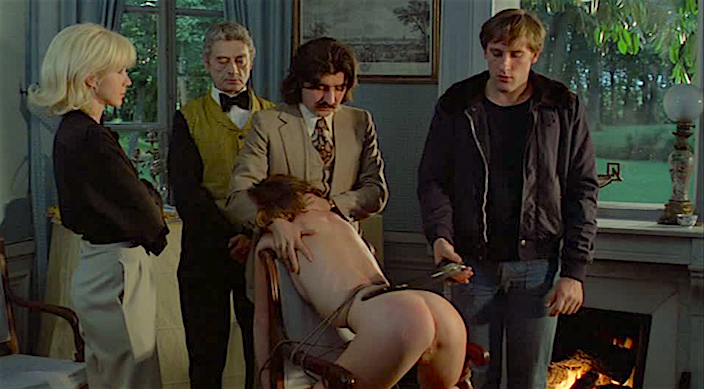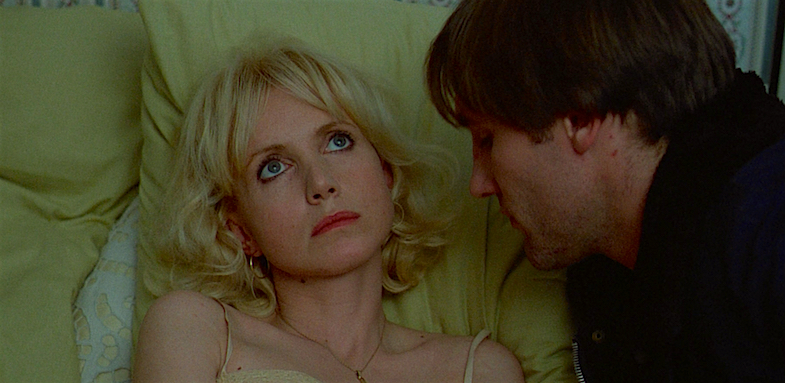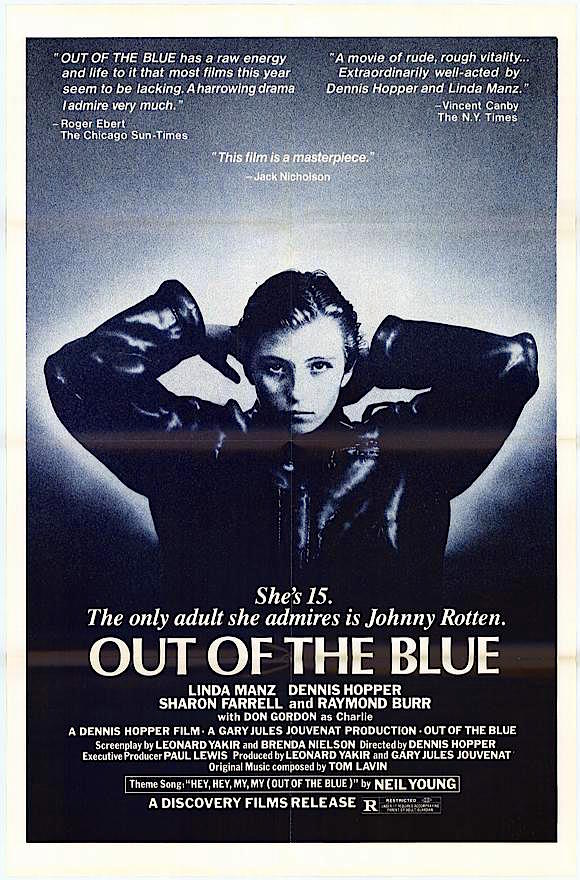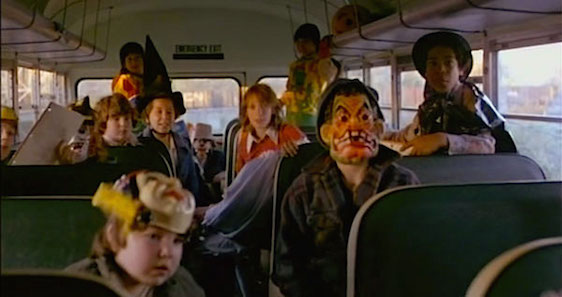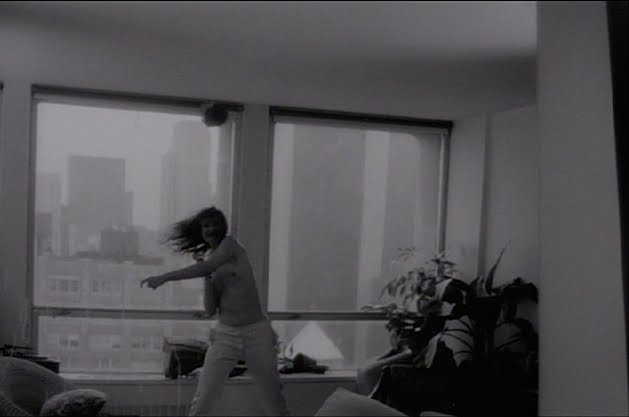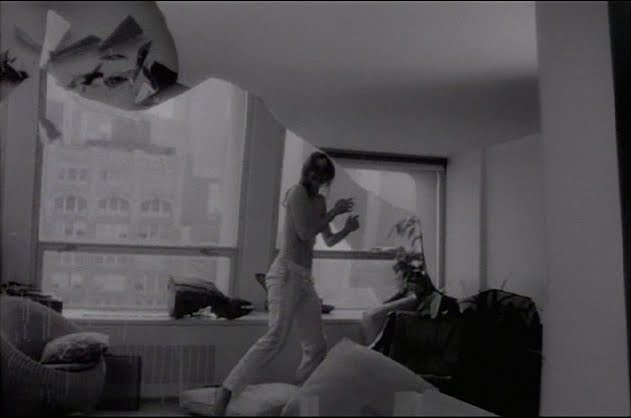You may not not fully recognize Memorex’s slogan or Steve Steigman’s iconic photograph unless you were born before 1978. Memorex Tapes were challenging listeners’ ability to judge between live performance and recordings of something that was once a live performance.

Memorex sound quality is blowing Peter Murphy away.
Photograph | Steve Steigman, 1979
The ability to distinguish fantasy from reality is gained sometime between the ages of 3 and 5. That doesn’t mean that a 7 year old will trust his mother when she tells him there are no such things as monsters. It also doesn’t mean that the child’s mother might not be able to fight the need to look in her own closet or under her own bed from time to time. The concept of “monster” changes as we grow into adulthood. Mom and Dad know there are no monsters in the house, life’s brutal truths leaves us all with a vague uncertainty about what potentially could be hiding under our beds. The mind’s perceptions related to “truth” and “false” are constantly shifting. Movies constantly challenge our process of thought.
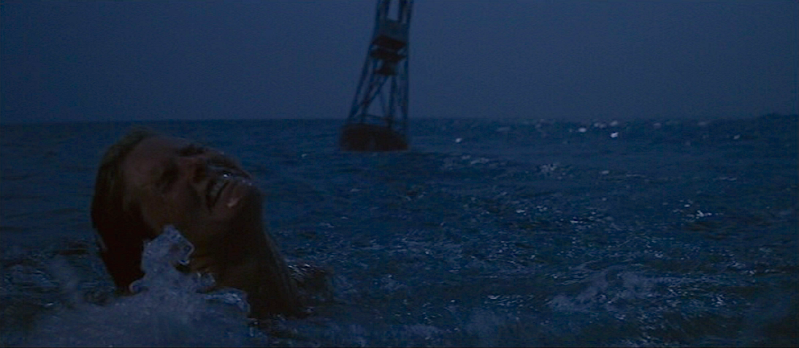
Have you ever been able to fully enjoy swimming in the ocean without thinking of that girl being attacked by the shark?
Jaws, Steven Spielberg
Cinematography | Bill Butler
Logic tells us that being attacked and consumed by huge shark is not only highly unlikely, but close to impossible. Logic also refuses to let go of the very real horror that Steven Spielberg’s Jaws lodged deep within our collective consciousness. We know that Michael Myers is not in our house, but there will always be a vague worry that someone like him might not have followed us and now waits to attack us. Movies play an important role in life beyond entertainment. Film Art projects our hopes, dreams, fears and reality in deeply effective ways. Our ideas and certainties often find themselves being challenged by the Film Artist’s motivation. Whether the intent is to manipulate us into fear or to bend it to suspend them to accept fiction as fact or to force our attention on an idea in a whole new perceptive. Defining the art of documentary from the art of fictional film is often more difficult than can be easily articulated.
The Blair Witch Project played with the idea of turning “found footage” intended for a film student’s documentary into the horror film genre. In the years since Daniel Myrick & Eduardo Sánchez’s 1999 low-budget classic seeped first tripped many film viewer up at the cineplex, this idea is has been explored so much that it is increasingly hard to fool us. The Blair Witch Project has become a symbol of parody and a lingering source of cinematic inspiration. It is interesting how most refuse to admit how this 1999 movie has changed the experience of camping in the woods. Interestingly, the sounds of what could potentially be a very real threat of a bear has morphed into an idea of some paranormal demonic presence. It takes only a few seconds to push the irrational fear away so the we can focus on what could be a “real” concern.

This screenshot of Heather Donahue became iconic within less than a week of the release of The Blair Witch Project, Daniel Myrick & Eduardo Sánchez, 1999.
The power of a talented film director lies in his/her ability to utilize motivational intent to sculpt fiction into reality or reality into fiction to form a bridge toward “the truth” that leads the audience. It is not unusual for an artist to be somewhat fixated or even obsessed with one or maybe two core themes that runs his/her entire collected works. It is also not usual for an artist to approach a wide variety of themes by use of one particular style. What is rare is to discover an artist as self-aware of not only his work but what truly motivates him to pursue it. Werner Herzog never uses vague or opaque terminology when he discusses film. He is blunt in addressing questions related to his work and his opinion of the type of film art that appeals most to him.
“You should bear in mind that almost all my documentaries are feature films in disguise.” – Werner Herzog
His interests revolve in the way humanity attempts to interact with nature which inevitably lead his audience to an idea that seems to bother many. The core idea is that nature’s beauty is deceptive. Herzog sees nature as a place of cruelty, chaos and danger. Despite this bleak view, he is a major advocate of saving it. But the most interesting aspect of Herzog’s work is that he loves exploring the perplexing ambition of humanity to bend nature to his needs and dreams. Werner Herzog loves dreamers and the pursuit of their dreams. These dreamer might take the form of a sociopathic warrior, an obsessive music fan, a drug addled cop, a brave soldier, a naive amateur environmentalist, or a vampire — These dreamers eventually must wake and face their irrelevance to “The Beast” of the earth’s natural power. Aside from the fact that Herzog has always expressed his logical views and awareness of the chaotic world of nature, he still fully relates to his flawed cinematic dreamers.

While Fitzcarraldo is a narrative feature film, the feat of pulling of undertaking the task of pulling a boat that size up a mountain was brutally real. Klaus Kinski as Fitzcarraldo, Werner Herzog, 1982.
Cinematography | Thomas Mauch
Herzog seldom applies any trace of what I would call “style” — even his surrealist work is grounded in a very simple application of camera. Both Aguirre Wrath of God and Fitzcarraldo are both amazingly beautiful and take full advantage of the surroundings in which his dreamers find themselves. But the camera work is economical and usually static. They both have the look of a documentary. Regarding the making of both these movies, Herzog and his team encountered more than a few major challenges. These challenges were often as dangerous and unbelievable as the stories themselves. Defining documentary as “truth” and narrative film as “fiction” restricts artist, subject and audience from understanding how to engage.
Herzog’s brilliant film is not a fictional film. It is based on the Carlos Fermín Fitzcarrald, a 19th Century Peruvian rubber barron who managed to fight all odds and transport a 30 ton steamship across a treacherous isthmus (or strait of land) and then onwards from one challenging river to another. He and his team did this by dismantling the ship into pieces and reassembling it once destination was reached. This feat obviously caught Herzog’s imagination, but he had no problem in mixing fiction with truth. As Fitzcarraldo, Klaus Kinski conveys a passion that quickly turns into almost insane obsession. So strong is his love of opera that is determination knows no bounds in bringing that music to the culture in which he lives. The core of Fitzcarraldo is one man fighting any and all odds in pulling a 300 ton steamboat over an isthmus between the Urubamba and the Camisea rivers. Herzog not only increased the boat by ten times the truth, but he had his protagonist achieve it without any dismantling.

The movie that almost defeated Werner Herzog who nicknamed himself “Conquistador of the Useless”
The Infamous Steamship in Fitzcarralod, Werner Herzog, 1982.
Cinematography | Thomas Mauch
Not only did Herzog, his dedicated crew, and the tribal Aguaruna people of the region have to join forces to make this happen they also had to deal with the insanity of Klaus Kinski while doing it. Herzog uses no special effects. He and his crew really pulled that huge boat up and over the mountain. Misunderstandings between cultures resulted in tribal members destroying camp sites. Frustrations and exhaustion created intense fits of rage. Friendships and cultural relations were pushed beyond well past acceptable boundaries. Mount all of this with the perspective that the tribal Aguaruna men so detested Klaus Kinski they wanted to kill him.

Klaus Kinski winning friends and influencing people.
Fitzcarraldo
Werner Herzog, 1982
Cinematography | Thomas Mauch
Tragically, three of the six film artists on the boat as it crashed against the rapids were seriously injured. To be clear, Herzog was one of the six on the boat. Consistently honest and open to discussion, Herzog has stated that he used all tensions to the benefit of the energy we see in the film. All challenges were faced and ultimately met head-on. The result is one of the most interesting films of not only its era, but of all time. Even with 34+ years of time since, Herzog is still often in the position of defending his choices during the staggering production of the iconic movie.
The sheer beauty and idea of a man and his pursuit of a dream against all obstacles may not be new in “concept” but never has it been portrayed in such a painfully realistic way. How does one actually define “truth” and “fiction” when it comes to Fitzcarraldo?
The level of will, risks of danger and dedication required by the production is the stuff of legend. But this is legendary truth. Les Blank’s documentary, Burden of Dreams, is focused on Herzog making Fitzcarraldo is almost as interesting as the film itself. Les Blank captures The Artist grappling with not only incredible odds of completing production — it also captures Werner Herzog worn down past the point of exhaustion, but on the brink of re-thinknig his own personal identity to filmmaking, to nature and to life itself. It serves as a historic document of filmmaking. The distinction between “truth” and “fiction” are more clear in Blank’s Burden of Dreams. Or are they?

Werner Herzog discusses his worries and concerns as the boat sits stuck at the bottom of the mountain. Burden of Dreams, Les Blank, 1982.
As Les Blank films the ever-mounting challenges, failures, tensions, fatigue and dangers involved in bringing Fitzcarroldo to the screen — we are able to actually see how Herzog and all involved managed to do what we see in the film. However, there are moments in Blank’s documentary that make it all too clear that everyone knows they are being filmed. There is no escaping that in any documentary, but when you are filming artists at work some of what is said or how things are done take on a greater significance. This is especially true early on before everything begins to unravel beyond control. It is obvious that Klaus Kinski’s personal vision of reality has long been loosely defined.

Klaus Kinski in one of many rage filled rants at poor Walter Saxer, Production Manager.
Most interesting is the way we first see Herzog discussing his views of nature vs. Kinski’s attitude. Herzog loves to discuss ideas. So the content of what he tells Les Blank is all familiar. But to hear these ideas within the context of “where” he is both geographically and psychologically does not seem to fit. There is a most definite air of performance. It is only as Herzog’s determination, patience and passion began to collapse from tensions and exhaustion that Blank actually captures Herzog at his most self-aware and most distanced from the concept of Blank’s camera. “If I abandon this project, I would be a man without dreams and I don’t want to live like that,” he tells Blank. As the production gets closer to completion, Blank asks what he plans to do next. A surprising defeatist attitude comes forward: “I shouldn’t make movies anymore.”
Lucky for us that was exhaustion speaking. Herzog would go on. As he moves further into documentary filmmaking his artistic motivation remains consistent. Contrary to what many would like the audience to think, Herzog is not a cruel man. “Exploitation” is a problematic word when it comes to The Creative Arts. I do not feel Herzog “exploits” his subjects more than any other filmmaker. He does sometimes manipulate and approaches all subjects/topics in a distinct pursuit from the moment productions star though to the post-production editing and narration. Herzog bend and adjust the focus of the camera’s lens on reality so that it captures his motivational intent of showing us his personal “truth” — and that is not far from how fictional narratives are made.
I did entertain the idea of writing about these films in a chronological order, but when discussing the art of documentary vs. the art of Narrative Film — it just seems most natural to start with Herzog and then immediately turn to Errol Morris. While the motivational goals of both filmmakers are different, there is a very strong connection in the way both artists capture humanity and the many ways we either adapt or refuse to adapt to our environment and the others with whom we share it. It is also no secret that Werner Herzog played a key role in helping Errol Morris to stick with his vision and get his film completed. Herzog even stated that he would eat his own shoe if Morris would finish his movie. Ever true, Herzog ate his shoe in front of a full house at UC Berkeley forever captured in Les Blank’s Herzog Eats His Shoe.

In support of Errol Morris’ Gates of Heaven.
Herzog Eats His Shoe
Les Blank, 1980
It is challenging to think of an art form that is more collaboratively dependent than filmmaking. Every member of a film crew and crew is crucial to the outcome of each scene. And when the crew is minimal it often only enhances the need for collaborative unity in bringing all skills and talent together to meet the director’s vision. I’ve always thought of the director as an intensely driven orchestra conductor. The director must find ways to guide, motivate and gain the trust of everyone behind and in front of the camera(s). Some are better at this than others. I’ve noticed that the directors who most interest me tend to have the reputation of being more open to new ideas and feedback from his/her crew/cast but never never to the point of breaking away from her/his artistic intent. I suspect it is a very fine art of balancing perspective to be open enough, but finding a way to close it without turning the other artists against him/her.
Over the years since Gates of Heaven and Vernon, Florida, Errol Morris has evolved a system of documentary filmmaking that is efficient and effective. But no matter how his approach has changed, Morris cares about his subjects. They trust him as much as his crew. He consistently produces powerful and polished documentaries. As good as his current work is, he has never found a way back to the casual approach applied that created as magic or human as Gates of Heaven.

Transcending The Art of Documentary Film.
Gates of Heaven
Errol Morris, 1978
Cinematography | Ned Burgess
No matter how many times I watch Gates of Heaven — and I have watched it over and over ever since it came out on VHS — I always notice something new or I discover something deeper of myself hiding within it. As one of the pet owners attempts to needlessly defend grief, he says “There’s your dog; your dog’s dead. But where’s the thing that made it move? It had to be something. Didn’t it?” Over time, these people and their respective observations Errol Morris captured have consistently taken a deeper meaning for me. I’m not alone in that feeling.
Errol Morris had not yet fully grasped what would serve as his artistic motivation. In the mid-1970’s he only knew what he found interesting. The starting point seems to have been an article he read in the newspaper. Some sort of falling out between the owners of a small pet cemetery had led to the decision to sell the cemetery’s land to a corporate developer. While the soon-to-be former owners of the cemetery have found a way to remove the deceased animals and transfer them to another pet cemetery, the former pet owners were upset. This was the starting point of Errol Morris unforgettable feature debut. His starting point would lead him to unexpected discoveries that pulled him in a number of directions. It wasn’t until he sat down to edit the footage that he found his motivation: humanity.
Gates of Heaven was a true game-changer in the world of documentary filmmaking as well as to the general Art of Film. We now know that much of what Morris achieved was due to some lucky circumstances that seem to have not only inspired him but required him to come up with a way to get these people to actually talk with him. Gates of Heaven transcends beyond the typical ideology of “The Documentary Film” — the focus and tone are always changing as we watch. What appears to be a documentary about the reasons for the creation and demolition of one pet cemetery gradually appears to be leading us to the story of a new pet cemetery. As the “stories” develop his camera continually readjust “focus” to a wide variety of people who have some vested link. Morris’ initial interviews with the first round of owners feels familiar but somehow “off” — These people open up to Morris, but it seems as if he is attempting to stage them. There is a long shot of his first subject sitting uncomfortably under a tree. The camera’s perspective is distant. But soon we notice a distinct change in the manner Morris approaches his subjects. With the gift of hindsight information we know that Errol Morris discovered that people are more open when you allow them to decide where they will be filmed. He also discovered that the best thing he could do was simply ask one question and just keep the camera rolling. As these people begin to try and form an answer to his question(s) they began to forget the presence of the camera. They are actually speaking to Errol Morris as a person. He loses the identity of a filmmaker. They trust him.

Phillip Harberts reveals far more than motivational techniques or his new role working with his family in Gates of Heaven, Errol Morris, 1978. Cinematography | Ned Burgess
If you’re taking the time and attempting to read my ramblings — I’m confident that you’ve already seen Gates of Heaven at least once if not multiple times. The above screenshot is a classic example of Errol Morris’ technique. Sitting in his office surrounded by the objects that he most prizes, Phillip Halberts begins his infamous system for being an effective salesman. It is a truly funny scene of the movie. The key hers is that the viewer never loses sight of the fact that this guy is grappling with emotional and professional challenges that are all too familiar to any adult. We can’t help but giggle as he lists out his theory for success. But we can’t help but like him. Like nearly everyone featured in the movie, you find yourself wishing you could reach through the screen and offer some support.

“Oh! Wha- what was that? Was that a car? My goodness!”
Gates of Heaven,
Errol Morris, 1978
Cinematographer |
Ned Burgess
The main point here is that Gates of Heaven is important, valid and ageless documentary. Gates of Heaven offers nothing in the areas of the political, environmental, social or ethical issue. Errol Morris found an entry point into the deepest concerns of humanity. The only artistic motivation is focused down to exploring the deep need for connection, love and understanding. In the end, it has very little to do with the pets. It is about the humans who love them.
Albert and David Maysles began their careers firmly rooted in the idea that they were not really “Documentarians” — Both brothers were devoted to the idea of cinéma vérité or, more accurately, The Maysles Brothers viewed their films as “Direct Cinema.” In other words, their artistic motivation was to capture reality as it happened and then to turn it all around to question the validity of the “reality” captured. Direct Cinema doesn’t clearly define a boundary between the filmmaker and the situation/subject that is being filmed. Albert and David Maysles and their fellow collaborators had no problem if they became a part of the situation or developed a friendship or disdain with their subjects. The idea of “reality” is always in question when Direct Cinema technique is applied. Direct Cinema film artists welcome confusing concepts of reality. But it is fairly well documented that neither of The Maysles had any idea that their interest in Big Edie and her daughter, Little Edie would become a cinematic and cultural milestone.

Little Edie asserts herself despite the signs of decay that surround both she and her mother, “…you see in dealing with me, the relatives didn’t know that they were dealing with a staunch character and I tell you if there’s anything worse than dealing with a staunch woman… S-T-A-U-N-C-H. There’s nothing worse, I’m telling you. They don’t weaken, no matter what.”
Grey Gardens, Albert Maysles & David Maysles, 1975.
Perhaps even more importantly, the fact that they both found themselves caring about these two women. It would be challenging to touch on all of the aspects of culture and film that Grey Gardens influenced. Too strange and intense to match the easy-access of Errol Morris’ Gates of Heaven that would follow over three years later. Grey Gardens became a cult hit that slow-burned itself into the cultural thumbprint of America.
Edith Ewing Bouvier Beale / “Big Edie” and Edith Bouvier Beale / “Little Edie were the aunt and cousin of Jacqueline Kennedy Onassis. At one time these two women were major players in the world of wealth and influence.

We will never really know what happened to this beautiful and vital young woman to make her retreat into seclusion. But we can’t forget Little Edie.
Grey Gardens
Albert & David Maysles, 1975
But by the mid-1960’s they had officially slipped into an isolated world. They had already been living in the grand home for decades and labeled as “Crazy Recluses” for quite a while. Despite being supposedly well-monied, Big & Little Edie lived on limited funds for decades. The once stunning home officially named Grey Gardens in the 1920’s began to fall into decay. By 1971 the wealthy residents who lived near the estate began to file official complaints. They were living without running water, tons of garbage, a slew of cats as well as wild feral animals. Grey Gardens had become more than a somewhat hidden eye sore, it was officially a health hazard. They attracted unwanted attention from the media due to their connection to The Kennedy Family just before their County Health Department was about to condemn the property and evict both women. The media speculation was so intense that both Jackie Kennedy and her sister paid for the entire clean-up and repair of the house. Neither ever seemed to ever get over what they considered an attack by the media, but it Little Edie who seemed to be the most plagued with fear and paranoia.

Little Edie wearing ‘the best costume for the day’ and Big Edie frustrating over where in the hell she thinks she is!
Grey Gardens
Albert & David Maysles, 1975
It has never been clear to me how The Maysles Brothers secured Big and Little Edies’ permission to film them, but they did. And the method of Direct Cinema for documentary gave these two amazing but deeply eccentric women the opportunity to freely share their history and opinions to the camera. Grey Gardens is profound in the way it captures the on-going love/hate shared between mother and daughter.
“You can’t have your cake and eat it, too in life.” Little Edie casually points out.
“Oh, yes, I did. I did, I had my cake, loved it, masticated it, chewed it and had everything I wanted.” Big Edie responds with pointed glee.
At turns hilarious, disturbing, haunting, sad, grotesque — it is impossible to not love these two women. And while both take deep joy in “hamming” it up for the Maysles cameras — the film captures devastating moments of self-awareness, regret and longing that grip the audience so tight it can never let go or forget the movie. While the film is certainly a documentary, it is also just as certainly confused about what is “true” and what is “fiction” — Grey Gardens is a mysterious film that is unrelenting in confusing “reality” with “distorted truth” and often the deception of “memory” tinged with the need to “alter” truths — not for the audience but for these two women. It is a complex, fragile and beautiful film that refuses to tell us the truth.
European and Asian countries have specific eras of like-minded film artist who have created films at the same time that have resulted in what are easily identified as cinematic waves.

Welcome to the beginning of La Nouvelle Vague. The 400 Blows,
François Truffaut, 1959.
Cinematography | Henri Decaë
I’m unaware of any such occurrence in American Cinema. Aside from the Golden Era of Hollywood, I’m hard pressed to think of any American “waves” — our culture is too young and diverse. Once the old-school Hollywood studio system fell away there was a whole new generation of almost maverick-like filmmakers. But it seems that there was no singular shared voice at the same time. There was certainly a revolutionary shift in cinematic art starting in the mid 1960’s, but typically the American Film Artist tends to be somewhat of a loner. There are two American filmmakers and one American film that I want to highlight briefly because all three touch directly on depicting fictionalized reality or fictional narrative within an almost documentary-like approach. These two American Film Artists created two unique styles with two very different artistic motivations. And, then there is one film that really stands out and remains entrenched in my brain.
I don’t think anyone filmmaker can be named as “the best” or “the most influential” — art is far too subjective for that level of claim. That being said, the work left by Robert Altman is as relevant, interesting, provocative, experimental, unique and experimental today as it must have been when it was released. Some of his films fail. A few seem to get anchored in a sort of drug’d haze that alienates the viewer. But he made more than a couple of films which are true cinematic masterpieces. And when it comes to mixing ideas around reality with fiction, he was undisputedly a genius.

Largely credited with reinvented the language of cinema, Robert Altman working with Julie Christie on the set of McCabe & Mrs. Miller in 1970. Photographer unknown to me.
In this sense the key work is 1975’s Nashville. It is essentially an epic study of American culture just before it hit it’s 200th birthday. While it might seem odd that he chose to capture a snapshot of America via The Nashville Music Industry, it was incredibly clever. Like most of Altman’s 1970’s work, all the actors are mic’d. Unlike Altman’s prior work the actors are usually in filled spaces with non-actors. Only a very select few of the actors actually knew when one of Paul Lohmann’s cameras are focused on them. They had lines, but were free to “riff” or alter lines if it felt more believable to do so. Those actors who were playing musicians or actual County & Western Stars were required to write or co-write their songs as wall as to play/sing them. And, as Altman was constantly changing ideas or re-writing scenes, it is my understanding that no one had a full screenplay of the film while it was being shot.

Long before we had access to cyber “search engines” like IMDB, viewers could easily mistake actor, Bill Jenkins, as a “real” Nashville TV reporter.
Nashville,
Robert Altman, 1975
Cinematography | Paul Lohmann
When combined with Altman’s grim view of the state of American culture and it’s ever-growing obsession with fame — Altman was taking a big risk. Nashville could have easily been a meandering mess. Instead it is a darkly funny, insightful and disturbing film. Nashville does meander, but all of the subplots and characters are slowly working their way to a conclusion which remains a topic of controversy within the world of celebrity. Not that entities such as The Academy Awards should ever be given the level of ultimate cinematic valuation that it is often allowed, but it is likely the disquieting view of both “celebrity” and American culture which prevented Nashville from being honored as 1975’s best film.
As Altman’s cast intermingles with valid country musicians, non-actors and actors playing versions of themselves — this fictional film takes on a vibe that feels real. Nashville is filled with awkward, comic and disturbing moments inter-laced to create an uneasy tension. We forget that it is Laugh-In’s Lily Tomlin struggling with her duties as a wife, mother, desires and self-identity within cultural and societal pressures. When she allows herself to be seduced we are surprised in the discovery that she not only fully understands the Keith Carradine’s hollow vacancy, she is not bothered by it. The womanizing soon-to-be major recording artist seems as shocked as we are when this “truth” is passively revealed. “Tom” croons that he is “easy” but he is actually very difficult. It is here that Robert Altman and three actors push fictional moments into the realm of painful reality. This points to one of the many key reasons Nashville is so powerful. Altman films his epic like a documentary. It is an essential film and a classic example fiction merging into deeper truth than the viewer anticipates. The suspension of disbelief is not really so much as an audience choice but a clever manipulation to force it. From the most superficial to the deepest core, Nashville is disconcertingly real.

Lily Tomlin’s comic persona disappears as a conflicted wife becomes the focus of a musical lothario. She is not ‘easy’ in Nashville, Robert Altman.
Cinematography | Paul Lohmann
No one filmmaker has ever been better at blurring the lines of reality and fiction than John Cassavetes. It is my opinion that all true lovers of cinematic art holds at least one Cassavetes movie close to the heart. A Woman Under The Influence is the best example of a filmmaker’s motivation applied in what appears to be either a very loose improvisation of reality or an obscure documentary of a family in crisis. With hindsight we know that nothing about this film was improvised or real, but a viewer would have to be truly emotionally stunted not to find her/himself challenging those facts as this movie unspools. Gena Rowlands has earned a unique place within the world of cinematic acting — and, when carefully studied, it is impossible to name any actor or actress who displays such effective naturalized performance. I view that statement as fact. Rowlands has charisma, presence, natural grace, impossible beauty and an ability to merge identities into characters like no other. For 135 minutes, Gina Rowlands is Mabel and Mabel is Gina Rowlands.

“All of a sudden, I miss everyone…”
Gena Rowlands
A Woman Under The Influence
John Cassavetes, 1974.
In A Woman Under The Influence Cassavetes artistically approaches everything as simply and as minimally as possible. Rowland’s Mabel is car wreck waiting to happen. The late and criminally underrated, Peter Falk, is equally realistic Mabel’s confused and helpless husband. As Mabel’s emotional grounding becomes shakier with each passing moment, Peter Falk tackles the issue from every perspective he can find. When he turns to the equivalent of domestic abuse we are so unsettled that we barely have time to recover before their children jump in to protect their mom. When Mabel finally breaks, it is disorienting to determine if it Mabel or Rowlands having a nervous breakdown. The complexity and fragility of mental illness is almost too realistically articulated. It is terrifying to watch. Without any frame of context, Cassavetes’ cinéma vérité style could easily mistaken for a 1970’s documentary of a family coping and functioning through crisis. John Cassavetes was always very clear regarding his artistic motivation. His goal was to capture real love in film. It is at the heart of every film he ever made. He had no interest in vasolined-screened mush. He sought out the realities of love. His muse was his wife. Together, he almost always hit his mark. As dark and disturbing as A Woman gets, there are two things we know about Mabel and her husband: they are in love and they have each other’s backs no matter what challenges come their way.

Is it Mabel who is slipping into an emotional breaking point or is Gena Rowlands slipping with her?
A Woman Under the Influence, John Cassavetes, 1974.
Cinematography | Al Ruban
Many cinephiles of my generation or older feel that the levels of Film Art which which these artists’ reached is no longer possible. This opinion is not true. A number of current film artists are even more strident in applying individual motivations which artistically merge truth with fiction than ever before. Independent Filmmaking has never been easy. Technology has provided tools and platforms that potentially allow anyone to make a movie. Too many movies are being made for film festivals to fairly evaluate what films get on their screens. And Film Critics are finding it impossible to actually review the number of films that manage to get distributed. he challenges of getting worthy art shown and distributed has never been harder. There are too many movies being made. And because anyone can make them it is a challenge to determine which independently funded films are worth the time to watch. Esteemed New York Times Film Critic, A.O. Scott sendt an email to Variety this year stating, “Because of the increasing volume of new films released each year, the Times is no longer able to guarantee reviews of all New York theatrical releases.” It is not hard to understand why The Times had to make this decision, but it doesn’t minimize the impact. A review from The New York Times can “make” or “break” a film artist’s career.
Looking at the challenge from another perspective, I’ve never seen film artists approach a challenge with this creativity, tenacity, energy and devotion. Unlike the late ’80’s/’90’s, the artist’s who seem to really succeed are the most devoted to their art. I find the drive and work of these new filmmakers incredibly powerful. I’m not a film critic. I just love cinema. But like many of my friends I had started to feel sad about the state of American Film in the year that actually gave us some amazing film. Pulp Fiction, Clerks, Ed Wood, Red, Muriel’s Wedding, Chungking Express and even Oliver Stone’s admittedly questionable but highly experimental Natural Born Killers — all came out in 1994. But in 1994 I started to note a shift in many of my peers perspective regarding films. This next remark is likely to earn me a number of angry emails, but I loathed Forrest Gump, Four Weddings and a Funeral, Interview with a Vampire and The Lion King. It was around this time that my closest friends begin to tell me I was a “movie snob”

“Epic in scope and triumphant in spirit!” or passively unconcerned solutions for PTSD riddled war veterans, marginalized people and protestors of War? Forrest Gump
Robert Zemeckis, 1994
Skip forward a decade and I actually was afraid to tell people that I detested Paul Haggis’ Crash. I can remember a friend not speaking to me for over a year because of my opinion. This is particularly interesting because I’m not an aggressive person when it comes to my opinions. I have them, but I don’t expect everyone to agree with me. Sometimes I’m surprised when even one person agrees with me. So, I knew this movie was really a “hot” topic for white people. When I said that Haggis might be well-intentioned but the whole movie was so ham-fisted and too simplistic in resolutions that I felt insulted. I had a similar reaction when Jonathan Demme made Philadelphia over eleven years earlier. But in 1993 my “crowd” more or less agreed with me — or were at least willing to admit to the painfully “black and white” approach to only partially-formed characters. By the time every major film critic and the Academy Awards chose Thomas Langmann’s The Artist, which I hated, 2011’s best film, I seldom ventured to the cinema. The movies that were interesting me were harder to see on the screen. My two personal favorite films of 2011 were Steve McQueen’s Shame, Evan Glodell’s Bellflower and Lynne Ramsay’s We Need To Talk About Kevin. I was able to see two of these films on the big screen.
Living in San Francisco I was surprised when I was unaware of it having played here. I had to wait for it on blu-ray. When I suggested each of these movies to friends in West Virginia and Ohio, neither were able to find them screening in their areas. Interestingly, Terrence Malick’s Tree of Life screened in their areas. Maybe I was hoping for too much as I entered The Sundance Kabuki Cinema to watch Malick’s film. I’m not sure. I was entranced by Emmanuel Lubezki’s cinematography, but I was never actually engaged by the film itself. Both of these friends contacted me after they had seen it. They were excited and loved Tree of Life, but as I discussed it with each of them — I discovered that neither understood what they had seen. The fact that I found myself explaining it twice to two very intelligent people confirmed my assessment of the movie. My two pals were claiming to like the movie because so many of the critics liked it.

This can’t be Clint Jordan, right? No, this has to be
Virgil Bliss, Joe Maggio, 2001.
Cinematography | Harlan Bosmajian
In my spare time, I’ve worked for film festivals. I’ve even served on the board of one that has become fairly influential. It was involvement with a Film Festival that offered me the opportunity to see two films before they had secured distribution and were released. The first was Joe Maggio’s Virgil Bliss starring Clint Jordan as the title character. I was hooked from the beginning to the end. Maggio’s film was a lo-fi character study of a recently paroled criminal who desperately wants to secure a stable life. I had never seen Clint Jordan play a character this complex. It didn’t even feel like I was watching a movie so much as some profane transmission from reality’s grimmest corner. A couple of years later I would see Debra Granik’s Down to the Bone, a brutally realistic story of parenting and addiction which featured an unforgettable Vera Farmiga. Granik and Farmiga pulled me into this horrifying world. Both of these films were intensely intimate and painfully “real” — I will never forget them. They did secure distribution but largely thanks to the DVD and streaming markets.
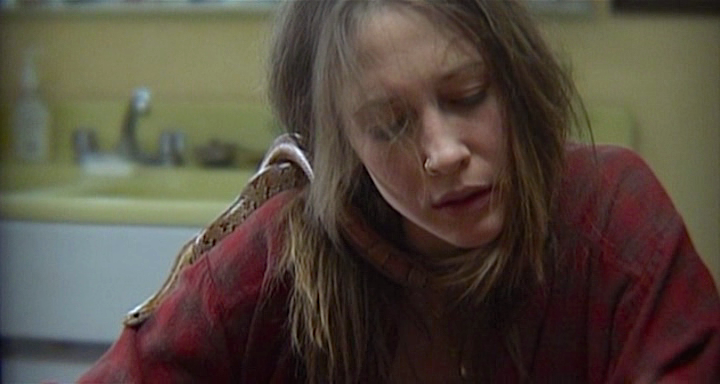
Vera Farmiga’s performance as Irene takes on bleary and almost horrifying level of reality in Down to the Bone, Debra Granik, 2004.
Cinematography | Michael McDonough
And, then I started hearing about Mumblecore. A term I still dislike as it seems more than a little pejorative. Joe Swanberg and Greta Gerwig were the first of the “Mumblecore Movement” I saw. Both of these artist are naturalistic actors, but most importantly they are filmmakers who have disarming ways of presenting intimate and relatable characters that often feel so real that you find yourself squirming in your seat. Early on the co-wrote and co-directed Night and Weekends. With no budget and a non-apologetic manner of presenting themselves as actors, their movie challenges the audience in determining which of the two characters are more vested in this relationship. When the two lovers eagerly disrobe and have sex, the absence of any pretense of eroticism and the immediacy of the two characters’ mutual desire makes the audience feel like ashamed. It is as if we are voyeuristically looking at something private. At some point, it is impossible to discern these two filmmakers from the characters that they are playing. Insightful, sad and real — The movie refuses to be dismissed. The same goes with Joe Swanberg’s previous film staring Gerwig, Hannah Takes The Stairs.

A young couple struggle with the challenges of a long distance relationship in Nights and Weekends,
Greta Gerwig & Joe Swanberg, 2008.
Cinematography | Matthias Grunsky & Benjamin Kasulke
Both Greta Gerwig and Joe Swanberg have pursued their artistic goals with a vengeance. Not to be conceived as a criticism, but Gerwig seems more comfortable in moving in the higher powered/monied productions of Whit Stillman, Noah Baumbach and Woody Allen. Whether that is luck or successful networking, Greta Gerwig has firmly established herself as a unique actor and filmmaker. It would be impossible not to mention the work of Mark and Jay Duplass who have both managed to move comfortably into mainstream without selling out. The same is true for Lynn Shelton who has achieved a great deal of success. Ti West has also found a great deal of success in the horror genre. Michael Tully is another to emerge as a truly riveting filmmaker. Also of note are the works of Lawrence Michael Levine, Sophia Takal and Onur Tukel within the realms of comedy. Amy Seimetz is another incredibly amazing actor who has thus far made one film, Sun Don’t Shine, which was one of the best films of 2013. Aside from Seimetz’s skill as an actor, Kate Lyn Sheil is probably the second most valuable player as an actress.
Joe Swanberg’s interests in film seem to be more committed to remaining the chief architect of his work. His talent and skill are unquestionable, but it wasn’t until he was able to collaborate with Kent Osborne and make Uncle Kent that his strength was crystal clear. Osborne is well established in the world of animated film art. In Swanberg’s Uncle Kent, Kent Osborne is playing a version of himself which leaves a great deal of mystery for the audience. We have no way of knowing when we are seeing “truth” in fuzzy sort of staged way or in a sort of re-enactment. Osborne is so believable in this film that it is more than a little difficult to know if this is made up or a very slanted manipulation of reality. Either way, the film works incredibly well. Swanberg does not deviate from his deceptively loose and slow pacing. In Uncle Kent we see a successful LA Film Artist who, through a series of increasingly uncomfortable moments of self-awareness, must come to grips with the fact that not only is he getting older — he is now finding it difficult to fit in and relate to the friends who populate his world. And his world appears to be made up of working on adult-oriented but infantile comedic cartoons, doodling, surfing the Internet, participating in Online Roulette, getting stoned, petting his cat and hanging out with friends ten years his junior.

Kent Osborne, Jennifer Prediger explore sexuality with Josephine Decker in Uncle Kent, Joe Swanberg, 2011.
It is an entertaining but precisely executed examination of the formation of what will likely be a tough mid-life crisis. Another aspect of Uncle Kent that adds a great deal is the contributions of both fellow filmmakers and actors, Jennifer Prediger and Josephine Decker. Prediger plays Kate with a mix of humor and sadness. It is a surprisingly complex performance that catches the audience off-guard. She must be acting, but it never feels like acting. When Josephine Decker enters the film she brings a level of energy that Swanberg is able to use as a major catalyst for Kent. As most of us know, the erotic idea of a three-way usually quickly dissolves into awkwardness in which usually only two of three finds any real erotic pleasure. A three way is exciting in concept, but when placed into theory it is most often an unenjoyable realization of interpersonal dynamics that are better off unexplored. This is certainly the case in Swanberg’s three-way scene. It is a powerful moment in a surprisingly potent movie.
It is important to note that Jennifer Prediger has gone to make her own mark as a filmmaker collaborating with Jess Weixler to create the quirky, funny and unique look at friendship, Apartment Problems (or known to some as Trouble Dolls) Actually, The Duplass Brothers, Lena Dunham and Alex Karpovsky are not the only artists to find success. Meanwhile Josephine Decker continues to act, perform and create in various challenging and interesting projects. But most importantly Decker has recently made two vitally important films as both director and writer. Both of her directorial feature length films, Butter on the Latch and Thou Wast Mild and Lovely are truly essential films Decker’s path as Film Artist seems to be headed toward a more experimental direction. Josephine Decker is an important Film Artist that I suspect will be leading us in some very interesting directions. With her second film, she actually surpassed Shane Carruth’s Upstream Color, which was my favorite film of 2013. Another independent filmmaker to note is Patrick Brice whose recent collaboration with Mark Duplass, Creep, re-examines the ideas of “found footage” and “documentary” to amazing effect.

It’s creepier than you expect. Mark Duplass in Creep, Patrick Brice, 2015
In 80 minutes Brice/Duplass manage to deliver a movie that elevates the horror genre both intellectually and emotionally. On the surface, Creep is fun adult horror movie. It is long after the credits roll that the underlying power really “creeps” up. Sure, it’s only a horror movie. Now, keep telling yourself that as you realize that what you’ve just seen could not only happen — it most likely does.
I was a little late in learning about Kentucker Audley. A friend in NYC sent me a DVD of his first feature length film, Team Picture. Perhaps more than any of the other filmmakers to emerge under the term “Mumblecore”, Audley shines out as the boldest Film Artist. Much like Herzog, Audley is very open about his motivation regarding filmmaking. He has described his approach as being almost autobiographical documentary. It is and it most likely isn’t. The vital importance of Team Picture is the almost lazy feeling Audley applies as the minimal story unfolds. After only about five minutes into this movie, you can sense that Audley is far more schooled in the art of film than his film wants to show. A quiet film, Kentucker Audley plays David. David should be in college or seriously pursuing a career. Instead he is happy just to hang out with friends, strum his guitar and sit outside be the kiddie pool he uses to cool off in the summer sun. Despite the slow pace and drifting conversations, there is an odd pulse at play with Team Picture.
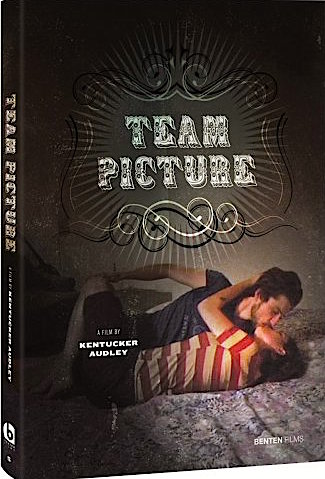
“I guess you don’t need any help with anything. That’s cool.” The line between reality and fiction feels partially erased in the passively crucial art of Team Picture,
Kentucker Audley, 2007
Cinematography | Timothy Morton
When Audley’s David decides to move on to another town it seems without any clear direction or purpose. However, we gain a gradual perspective into David’s life that reveals a childhood that offered him no clear paths to bonding with a male figure as well as a distinct level of confusion regarding his identity. A creeping sense that David’s environment and childhood have almost set him up. His expectations in life are muted. He is not a team player, but he has a confused need to somehow fit into the team if only for the purpose of momentary capture of belonging to something. Of the recent films to achieve a realism that feels more “true” than “fiction” — this might be the most powerful film.
In addition to being an important voice in modern film, Audley is an exceptional effective actor. I suspect his acting roles are how he funds his filmmaking work. But he will soon be seen in two important independent films: Jason Banker’s Felt and Alison Bagnall’s Funny Bunny. Audley has also positioned himself as vital member of the American Independent Film Artist World with his passionate approach to protecting the rights of individuality in Film Art with the creation of the user-friendly web site, NoBudge. He accepts submissions from indie-filmmakers and curates them on the site for free viewing and feedback. These are both feature-length and short films that might not hold the “commercial” accessibility required for film festivals and the increasingly powerful role of Aggregators to negotiate for independent films to be available for purchase/rental on digital media sites such as iTunes or AmazonPrime. But that certainly does not mean that they have a great deal to offer.
Check out NoBudge: http://nobudge.com
It was on Audley’s NoBudge site that I “discovered” Brandon Colvin. Colvin’s Sabbatical is a beautifully-rendered exploration of a man in crisis that adheres rigidly to Formalist Style. Colvin not only succeeds, he exceeds what one expects to find in a low budget film. Nothing about Sabbatical looks low budget. Sadly, Brandon Colvin’s masterful film is failing to secure distribution and an aggregator because Sabbatical does not “fit” or “conform” to the current ideas around what is commercial and what isn’t.
You can find out more about Sabbatical which also stars Robert Longstreet. An actor who so many of us admire. People are missing an amazing experience.
sabbatical-mossgarden.com

Eleonore Hendricks and Kentucker Audley try to fit into some part their culture’s frame in
Bad Fever, Dustin Guy Defa, 2012.
Cinematography | Mike Gioulakis
Dustin Guy Defa’s Bad Fever is another crucial film within the context of modern American Film Art. Kentucker Audley’s turn as a misfit and wanna-be comedian is more than just awkward and anxiety-inducing — it is tragic. Eleonore Hendricks plays Irene who quickly becomes Edie’s obsession. His desperation for her love is not only misplaced, it is inappropriate. Even within the context of Irene’s world, Edie’s presence is too worrying. Dustin Guy Defa’s experimental film delivers a constant stream of frustrated uncomfortable confusion hinged with potential violence. Nothing about this ver low budget film “feels” like acting.

Walter Bakes creates a beautiful music with only a rubberband as he wanders through the ever-changing landscape of Brooklyn and the calm-wild of Texas. An artists’ existential search and crisis that seems to require he pull his wife and child with him along the way. An uncertain future in A Rubberband Is An Unlikely Instrument, Matt Boyd.
Cinematography | 2011
Matt Boyd seems to be approaching documentary film with a style that is somewhere between the accepted notion of what documenting reality and The Maysles Brother’s type of Direct Cinema that leave the audience wondering when what we are seeing is real or possibly staged. His study of marginalized musician, Walter Bakes, and his family in A Rubberband Is An Unlikely Instrument is a challenging but rewarding examination of decay and self-absorbtion. It does not hedge from showing the warts and all of its subject but it never feels judgmental or exploitive. Matt Boyd is heading to an interesting career.
And as I come to the end of this rambling post, Rick Alverson must be mentioned. Along with Kentucker Audley, Alverson may be the most interesting Film Artist who is unrelenting in his pursuit of cinematic truth. Rick Alverson is far more concerned with style than Audley. This may end up being Alverson’s greatest challenge as filmmaker. His stylistic impulses sometimes appear to be at odds with the more immediate concerns just below the sensitive skin of his films. All the same, Alverson is building an amazing body of work. Best know for his 2012 film, The Comedy, which received a great deal of attention at the time of its release. It was praised and dismissed in equal measure. One of the dismissals came from my personal favorite Film Critic, A.O. Scott who caught me off guard when he was so frustrated by Alverson’s movie that he felt the need to attack those of us who saw the merit in it. According to A.O. Scott if I find any “critical distance” or “interesting perspective” in Alverson’s The Comedy — then I am the butt of Alverson’s joke. I do not know Rick Alverson and I have not ever read an interview with him. I only am aware of him by his work. Alverson was not joking with The Comedy. Alverson presents a level of white male entitlement and human cruelty without offering any evaluation or background. Thanks to an amazing cast of effective actors, all we really need to know is passively communicated in the sad eyes and pointless actions. We might not like the main character or any of his friends, but viewers would need to be equally emotionally-stunted, damaged and as casually cruel as these characters to not see the tragic darkness which Alverson masterfully examines.
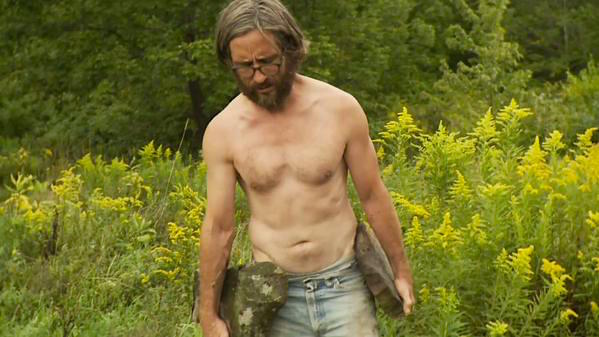
Doing his very best to push past what appears to be depression or something worse, Colm O’Leary slowly begins to construct his perception of an American home in The Builder, Rick Alverson, 2010
In The Builder, Alverson’s first feature which was made in 2009 and very limited released 201o — he collaborates with Colm O’Leary to create a very realistic study of an immigrant who attempts to pursue construction of his American dream house. O’Leary has a strong presence, but is allowed very little to say. The film is a bleak depiction of a man fighting through a depression in pursuit of something that seems to be failed abstraction of something deeper he can’t obtain. While the film offers viewers too little information to fully encage, it carries a power that is hard to forget. It feels like a film from an alternate universe of 1970’s American Filmmaking. We don’t understand this builder, but he feels far too real and familiar to forget.

Colm O’Leary and Will Oldham attempt to form a friendship for what appears to be two very different reasons.
New Jerusalem, Rick Alverson, 2011
In Rick Alverson’s New Jerusalem we are given more insight into the two men we follow. New Jerusalem touches on everything from faith to immigration to PTSD but it only barely touches this topics and themes. Alverson’s motivation is to explore an uneasy connection that begins to form between two men. This uncomfortable look at male bonding provides challenging ideas regarding the needs of male bonding. Ultimately, the viewer is never clear on why these two characters put up with each other. Aversion is not interested in resolving the tension and conflict. His goal is bring the reality of it to the audience.

New Jerusalem
Rick Alverson, 2011
The conclusion is left to us. The merging of “truth” and “fiction” will not always result in something simply entertaining and satisfying. Most often true art forces us to look at our own reflection and projections. Being able to fully understand the difference between real and fake is not always an asset. Most of human life is spent putting on one mask and quickly replacing it with another as we navigate our way through life. Not all of us want to escape from reality. Some of us want more from art than escape. I want to gain perspectives regarding the complexities and challenges of life. Like everyone, I want to know I’m not alone.

Little Edie notes the confusion of time, so do The Maysles Brothers artfully allow the confusion of truth. As the groundbreaking documentary was released over 40 years ago, it remains valid Film Art. Grey Gardens,
Albert Maysles & David Maysles, 1975.
“It’s very difficult to keep the line between the past and the present. You know what I mean? It’s awfully difficult.” – Edith ‘Little Edie’ Bouvier Beale







